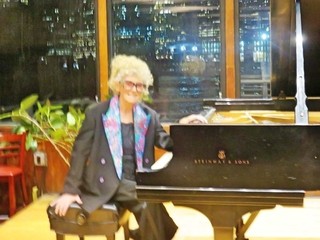|
Back
Virtuosity’s Questionable Virtue New York
BargeMusic
10/07/2016 -
Alexander Scriabin: Sonata No. 5 in F sharp minor, Opus 53
Franz Liszt: Fantasy on Themes from Mozart’s “Marriage of Figaro” and “Don Giovanni” (arrangement by Ferruccio Busoni)
Maurice Ravel: Scarbo from Gaspard de la nuit
Mily Balakirev: Islamey
Tamara Orlovsky (Pianist) 
T. Orlovsky at BargeMusic (© Samuel A. Dog)
To say the least, the subtitle of last night’s BargeMusic concert was an understatement. “Piano Virtuoso Music” encompassed four of the most unmanageable works of the late 19th and early 20th Century, all related in their difficulty.
Sviatoslav Richter considered Scriabin’s Fifth Sonata the most difficult piece in the whole piano repertory. Scriabin, on the other hand, no mean pianist himself, injured his hands while trying to play Mily Balakirev’s Islamey. Maurice Ravel, who was never a great pianist, said that in writing Scarbo, he wanted to make a piece of music more difficult than the Balakirev. And Franz Liszt, never one to leave great music alone, transcribed some of Mozart’s opera arias to an unheard-of difficult–only to have another virtuoso, Ferruccio Busoni, claim that it wasn’t difficult enough, so he re-transcribed the Mozart which Liszt had transcribed, making it (like all the works here) virtually unplayable.
Except of course for pianists who thrive on such challenges. Tamara Orlovsky was a prodigy in her native Russia, has performed around the world, and presently is Professor of Music in Indiana University. While she has performed in Carnegie Hall, this was the first time I heard her, and she did offer a dazzling display of this music.
Mind you, listening to four works like this one after the other, is like watching a breathless relay race, with one runner. Ms. Orlovsky ran through the paces of the Scriabin, passed the baton to Ms. Orlovsky playing the Liszt, then, after an intermission breather, began running again with the Ravel, and raced to the finish line with the Balakirev.
All quite remarkable. Yet somehow, one didn’t feel either enthralled or enlightened. It was good energetic playing. She needed no score to pound away at the piano (no, that’s the wrong word: she was relatively delicate). And one had all the respect in the world for–what unhappily became–her series of thorny, exacting, digit-numbing music.
Some were better than others. The Liszt piece had never been finished (though Leslie Howard reconstructed it later), and Busoni simply eliminated the Don Giovanni music to concentrate on Figaro’s “Non più andrai” followed by “Voi che sapete”. A fairly smart move, so that a pianist like Ms. Orlovsky could venture through the fantasy and we could keep up with all the familiar melodies.
Islamey was equally effective, simply because the music–great stuff for the virtuoso–was part of 19th Century Russia’s homage to the Noble Savages of the Far East. Rimsky, Borodin, Ippolitov-Ivanov and Balakirev tried to stylize the supposed musics of Islam the way Edward MacDowell trying to incorporate American Indian themes.
Balakirev was the victor, and his work is not only a technical tour de force but has a pair of “oriental” themes that are unforgettable (Borodin used one in Igor), and an actual imitation of an oudh in the finale.
Again, Ms. Orlovsky passed the digital test and ran through it without a stop. However, here, the middle Tranquillo showed just how much we ourselves needed to catch our breath.
The opening Scriabin Fifth Sonata was, one hesitates to say, excellent piano-playing, an introduction to more splendid technique. But Scriabin wrote this in tandem with one of his Poem of Ecstacy, and one rarely heard the mysticism through the music.
The late Scriabin never looked at virtuosity for its own sake, and here he accompanied the music with a Tantric command for “you drowned in the dark depths…embryos of life...it is to your that I bring daring.”
Nobody, not even Richter, could bring those ideas to life, yet their attempts at the impossible are worthy. Ms. Orlovsky played all the contrasting movements with speed (presto con allegrezza!!) or langour, and she ended with great intensity. The result, though, was respect (what a terrible word) for her performance, not that transport into Scriabin’s particular Nirvana.
I wish Ms. Orlovsky hadn’t put Scarbo amidst this music. Yes, Ravel’s mind (rather than his limited pianism) pushed the technical work to the nth degree. Yet Scarbo is a definite picture, one of three grotesqueries in Gaspard de la nuit. Those opening soft repeated notes, cross-cutting of themes, the nervous energy, the Walpurgisnacht horror of Scarbo’s laughter, his leaps from the ceiling…all of this must be somehow pictured amidst the cluster of notes. Ms. Orlovsky certainly played the notes well, she followed the dynamics, she never exaggerated Ravel’s commands. Yet the result was not an image, it was...well, as, the title of the recital went, pyrotechnical fireworks. And Ravel demands the Stygian evil as well as the white-and-black lights of the notes.
Harry Rolnick
|